-
Paper Information
- Next Paper
- Previous Paper
- Paper Submission
-
Journal Information
- About This Journal
- Editorial Board
- Current Issue
- Archive
- Author Guidelines
- Contact Us
International Journal of Hydraulic Engineering
p-ISSN: 2169-9771 e-ISSN: 2169-9801
2012; 1(6): 75-82
doi: 10.5923/j.ijhe.20120106.03
Analytical Solution for the Free Over-Fall Weir Flow Using Conformal Mapping and Potential Flow Theory
A. R. Kabiri-Samani, M. Amirabdollahian, F. Farshi
Department of Civil Engineering, Isfahan University of Technology, Isfahan, 84156-83111, Iran
Correspondence to: A. R. Kabiri-Samani, Department of Civil Engineering, Isfahan University of Technology, Isfahan, 84156-83111, Iran.
| Email: |  |
Copyright © 2012 Scientific & Academic Publishing. All Rights Reserved.
In this study an analytical approach is presented based on the potential flow theory and conformal mapping technique to solve the problem of an ideal and steady flow over a free over-fall weir. The results are arranged for rectangular sharp-crested over-fall weirs with different vertical aspect ratios (h/P, h is the water head above the weir and P is the weir height). To validate the results of this approach, the free over-fall weir discharge equation and the water free-surface profiles obtained with the potential flow theory have been calibrated with the experimental data. In conclusion, the information made available and the close correlation among the results of present analytical approach and the experimental data are adequate to warrant the recommendation of this method as a valuable supplement to existing methods employed in engineering design.
Keywords: Free Over-Fall Weir, Potential Flow, Conformal Mapping, Schwarz-Christoffel Transformation, Discharge Coefficient, Free-Surface Profile
Cite this paper: A. R. Kabiri-Samani, M. Amirabdollahian, F. Farshi, "Analytical Solution for the Free Over-Fall Weir Flow Using Conformal Mapping and Potential Flow Theory", International Journal of Hydraulic Engineering, Vol. 1 No. 6, 2012, pp. 75-82. doi: 10.5923/j.ijhe.20120106.03.
Article Outline
1. Introduction
- Weirs are simple and precise structures for flow measurement and control in open channels. Formerly, the weir equations were found mainly on the basis of experimental data. Based on the prevailing universal weir discharge equation, the discharge over the rectangular sharp-crested weirs could be revealed as[1]
 | (1) |
 | Figure 1. Streamlines and equipotential lines for flow over a free over-fall weir |
2. Theoretical Considerations
- In complex systems, a Schwarz–Christoffel technique is a conformal transformation of a simple polygon interior area onto the upper half-plane Im(z)>0, which is also used in potential flow theory and some of its applications. Suppose a polygon in the w-plane with vertices at w1, w2,…, wn and interior angles of α1, α2,…, αn. Where these points map onto points x1 , x2 ,…, xn on the real axis of the z-plane (Figure 2). Let G denote the interior of the polygon and D the interior of the upper half-plane. Then a transformation w = F(z) maps D onto G is given by the Schwarz-Christoffel transformation as
 | (2) |
 | (3) |
 | (4) |
 | (5) |
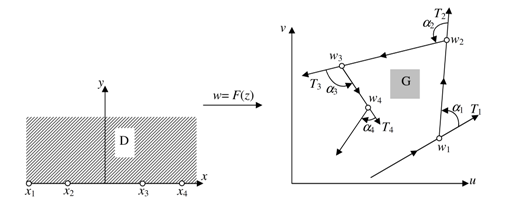 | Figure 2. Conformal mapping based on Schwarz-Christoffel transformation |
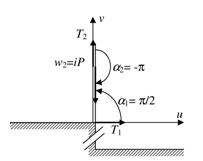 | Figure 3. w-plane, the complex potential plane corresponding to flow over an over-fall weir |
 | (6) |
 | (7) |
3. Model Experimentation
- To investigate the water free-surface profile and over-fall weir discharge equations, experimental study was performed in a rectangular glass open channel of 11 m length, 0.4 m width and 1.0 m height. Experimental setup consists of a circulating system including main channel, pump, upstream and downstream reservoirs, etc. The longitudinal slope of the channel was set to be zero. Free over-fall weirs were made of 3 mm thick steel sheets with sharp edged and fully aerated condition. Two weirs with P=5 and 10 cm were considered and placed at the mid-length of the upstream inlet above the corner of a 0.4 m high vertical drop. Series of tests were conducted for different flow conditions and each corresponding inlet discharge (Q) was measured using an ultrasound flow-meter with a precision of ±0.1 lit/s. The minimum of eight discharges between 20 and 60 lit/s were considered. To evaluate the velocity profiles aimed to investigate the flow structure at the test section, the 3-D velocity profiles were measured using an acoustic doppler velocimeter (ADV). The depths of flow along and across the channel and over the crest of the weirs were measured using a point gauge mounted on a movable beam with a precision of ±0.1 mm. Experiments were conducted for sub-critical, stable and free over-fall conditions.
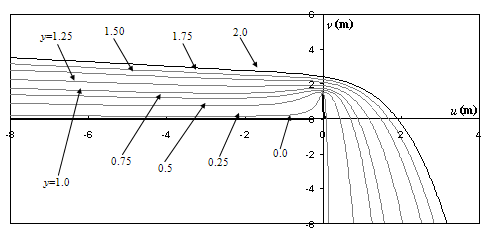 | Figure 4. Typical calculated streamlines over an over-fall weir with P=1.5 m |
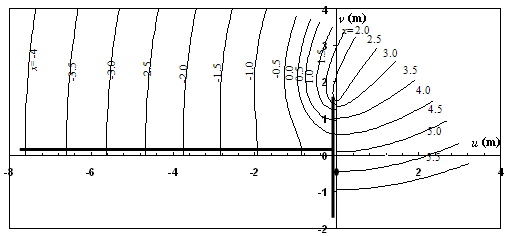 | Figure 5. Potential velocity curves over an over-fall weir with P=1.5 m |
4. Results and Discussions
4.1. Water Surface Profile
- In this section the analytical results obtained applying the potential flow theory and conformal mapping technique, are presented. As mentioned before, with the advances in analytical methods, computational models of flow through hydraulic structures are increasingly being used in industry, but they still require validation from experiments. For this reason, the analytical results have been compared against experimental measurements of the present study. The laboratory measurements regard the water elevation above the over-fall weir in order to track the free-surface profile. Consequent to applying the proposed analytical model, the water free-surface profiles were calculated for particular over-fall weir geometry by transforming the horizontal line passing from the upstream normal water depth (h) in complex plane, into physical domain using Eq.(7). Comparing the analytical results and experimental data indicated that, there were meaningful discrepancies between the analytical and experimental results of water free-surface. This is in part due to the simplifying assumptions of the potential flow. Hence, the theoretical results were improved based on experimental data and trial and error procedure using a quadratic correlation as follows:
 | (8) |
 | (9) |
 | (10) |
 | (11) |
 | Figure 6. The analytical water free-surface profiles compared with the experimental data for different h/P ratios |
 | (12) |
 | (13) |
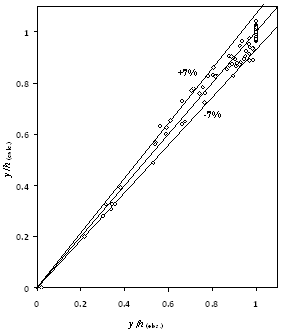 | Figure 7. Experimental versus theoretical flow depths |
4.2. Discharge Coefficient
- The complex potential of flow field includes two parts, (i) a real part, indicating the velocity potential (φ) and (ii) an imaginary part, which specifies the stream function (ψ). According to Eq.(7) x = cte and y = cte are analogies to φ and ψ functions, respectively. Based on numerical solution and applying nonlinear regression analysis the stream functions were expressed as follows:
 | (14) |
 | (15) |
 | (16) |
 | (17) |
 | (18) |
 | (19) |
 | (20) |
 | (21) |
 | (22) |
 is expressed as follows:
is expressed as follows: | (23) |
 . In this figure the majority of ±5% bonds are also attached. As is illustrated analytical results well compared with the experimental ones. The corresponding NRMSE, WQD and R2 values for the above relationship are 0.15, 0.003 and 0.98, respectively.
. In this figure the majority of ±5% bonds are also attached. As is illustrated analytical results well compared with the experimental ones. The corresponding NRMSE, WQD and R2 values for the above relationship are 0.15, 0.003 and 0.98, respectively. 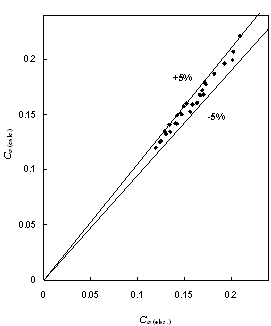 | Figure 8. Comparison between calculated and observed  |
5. Conclusions
- The overall goal of this study was to effectively model the fluid flow over free over-fall weirs using the conformal mapping technique based on the potential flow theory. The solution for the inviscid flow over free over-fall weir has been mapped successfully using Schwarz Christoffel transformation. Consequent to employing the potential flow theory, equations for determining the water free-surface profile and the discharge coefficient of the free over-fall weirs were obtained. The analytical results were calibrated according to an experimental investigation. The predictions of the semi-analytical model agree well with the experimental data related to water surface profiles and discharge coefficient. The results reveal that the Schwarz-Christoffel is the most accurate transformation to solve such problems compared with the other ones. The results are validated for large rang of h/P (i.e. h/P≤2.65, which are more practical in design considerations).
 Abstract
Abstract Reference
Reference Full-Text PDF
Full-Text PDF Full-Text HTML
Full-Text HTML